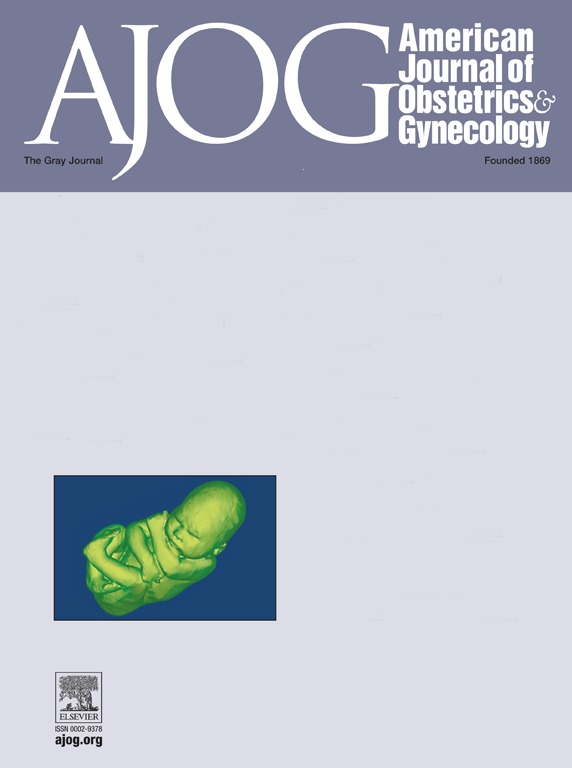A clinical ultrasound algorithm to identify uterine sarcoma and smooth muscle tumors of uncertain malignant potential in patients with myometrial lesions: the MYometrial Lesion UltrasouNd And mRi study
IF 8.7
1区 医学
Q1 OBSTETRICS & GYNECOLOGY
引用次数: 0
Abstract
Background
Differential diagnosis between benign uterine smooth muscle tumors and malignant counterpart is challenging.
OBJECTIVE
To evaluate the accuracy of a clinical and ultrasound based algorithm in predicting mesenchymal uterine malignancies, including smooth muscle tumors of uncertain malignant potential.
STUDY DESIGN
We report the 12-month follow-up of an observational, prospective, single-center study that included women with at least 1 myometrial lesion ≥3 cm on ultrasound examination. These patients were classified according to a 3-class diagnostic algorithm, using symptoms and ultrasound features. “White” patients underwent annual telephone follow-up for 2 years, “Green” patients underwent a clinical and ultrasound follow-up at 6, 12, and 24 months and “Orange” patients underwent surgery. We further developed a risk class system to stratify the malignancy risk.
RESULTS
Two thousand two hundred sixty-eight women were included and target lesion was classified as benign in 2158 (95.1%), as other malignancies in 58 (2.6%) an as mesenchymal uterine malignancies in 52 (2.3%) patients. At multivariable analysis, age (odds ratio 1.05 [95% confidence interval 1.03–1.07]), tumor diameter >8 cm (odds ratio 5.92 [95% confidence interval 2.87–12.24]), irregular margins (odds ratio 2.34 [95% confidence interval 1.09–4.98]), color score=4 (odds ratio 2.73 [95% confidence interval 1.28–5.82]), were identified as independent risk factors for malignancies, whereas acoustic shadow resulted in an independent protective factor (odds ratio 0.39 [95% confidence interval 0.19–0.82[). The model, which included age as a continuous variable and lesion diameter as a dichotomized variable (cut-off 81 mm), provided the best area under the curve (0.87 [95% confidence interval 0.82–0.91]). A risk class system was developed, and patients were classified as low-risk (predictive model value <0.39%: 0/606 malignancies, risk 0%), intermediate risk (predictive model value 0.40%–2.2%: 9/1093 malignancies, risk 0.8%), high risk (predictive model value ≥2.3%: 43/566 malignancies, risk 7.6%).
Conclusion
The preoperative 3-class diagnostic algorithm and risk class system can stratify women according to risk of malignancy. Our findings, if confirmed in a multicenter study, will permit differentiation between benign and mesenchymal uterine malignancies allowing a personalized clinical approach.
在子宫肌瘤患者中识别子宫肉瘤和恶性潜能不确定的平滑肌瘤(STUMPs)的临床超声算法:MYLUNAR 研究。
背景:良性子宫平滑肌瘤和恶性子宫平滑肌瘤的鉴别诊断具有挑战性。我们评估了一种基于临床和超声波的算法在预测子宫间质恶性肿瘤(MUMs),包括恶性潜能不确定的平滑肌瘤(STUMPs)方面的准确性:我们报告了一项观察性、前瞻性、单中心研究的12个月随访结果,该研究纳入了在超声检查中至少有一处子宫肌瘤病变≥3厘米的妇女。这些患者根据症状和超声波特征,按照三级诊断算法进行分类。"白色 "患者每年接受一次电话随访,为期 2 年;"绿色 "患者接受 6、12 和 24 个月的临床和超声随访;"橙色 "患者接受手术治疗。研究结果:共纳入了2268名妇女,2158名(95.1%)患者的目标病变被归类为良性,58名(2.6%)患者的目标病变被归类为其他恶性肿瘤,52名(2.3%)患者的目标病变被归类为间质子宫恶性肿瘤。在多变量分析中,年龄(OR 1.05 (95% CI 1.03-1.07))、肿瘤直径大于 8 厘米(OR 5.92 (95% CI 2.87-12.24))、边缘不规则(OR 2.34 (95% CI 1.09-4.98))、颜色评分=4(OR 2.73 (95% CI 1.28-5.82))被确定为恶性肿瘤的独立危险因素,而声影是一个独立的保护因素(OR 0.39 (95% CI 0.19-0.82))。将年龄作为连续变量、病变直径作为二分变量(截断值为 81 毫米)的模型提供了最佳的 AUC(0.87(95% CI 0.82-0.91))。风险分级系统被开发出来,患者被归类为低风险(预测模型值结论):术前三级诊断算法和风险分级系统可根据恶性肿瘤风险对妇女进行分层。我们的研究结果如能在多中心研究中得到证实,将有助于区分良性和恶性肿瘤,从而实现个性化临床治疗:无须声明。
本文章由计算机程序翻译,如有差异,请以英文原文为准。
求助全文
约1分钟内获得全文
求助全文
来源期刊
CiteScore
15.90
自引率
7.10%
发文量
2237
审稿时长
47 days
期刊介绍:
The American Journal of Obstetrics and Gynecology, known as "The Gray Journal," covers the entire spectrum of Obstetrics and Gynecology. It aims to publish original research (clinical and translational), reviews, opinions, video clips, podcasts, and interviews that contribute to understanding health and disease and have the potential to impact the practice of women's healthcare.
Focus Areas:
Diagnosis, Treatment, Prediction, and Prevention: The journal focuses on research related to the diagnosis, treatment, prediction, and prevention of obstetrical and gynecological disorders.
Biology of Reproduction: AJOG publishes work on the biology of reproduction, including studies on reproductive physiology and mechanisms of obstetrical and gynecological diseases.
Content Types:
Original Research: Clinical and translational research articles.
Reviews: Comprehensive reviews providing insights into various aspects of obstetrics and gynecology.
Opinions: Perspectives and opinions on important topics in the field.
Multimedia Content: Video clips, podcasts, and interviews.
Peer Review Process:
All submissions undergo a rigorous peer review process to ensure quality and relevance to the field of obstetrics and gynecology.

 求助内容:
求助内容: 应助结果提醒方式:
应助结果提醒方式:


